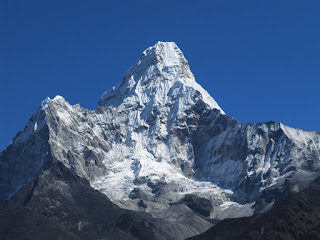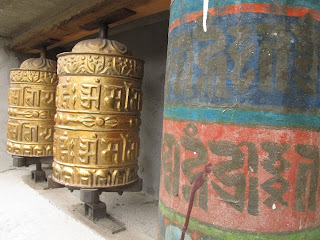As most things history have told us, dont EVER say things like this until you finish the task at hand.
The morning broke on Day 9 of the trek. The day's hike included about 4-5 hours of hiking from Dingboche (4280m) to Lobuche (4939m). One of the two most difficult parts of the trek was on this leg (The Thukla Pass) but that part was only 45 mins of the walk. The journey began on a really cold and windy morning. Oh yes, foreshadowing.

 As our hike progressed, the team started to feel the altitude more and more. My Canadian friend Christina nearly coughed out a lung on the way through the riverbed, and I began to feel an exhaustion through my body like nothing I've ever experienced. It was getting harder to take deep breaths and harder to move our legs from step to step. After 2 hours of gradual movement, we reached the bottom of the pass and a water break.
As our hike progressed, the team started to feel the altitude more and more. My Canadian friend Christina nearly coughed out a lung on the way through the riverbed, and I began to feel an exhaustion through my body like nothing I've ever experienced. It was getting harder to take deep breaths and harder to move our legs from step to step. After 2 hours of gradual movement, we reached the bottom of the pass and a water break.It was nice to take a rest, that is until one of our guides came running to us with bad news. After setting out on the same walk at 6am in hopes of securing rooms in Lobuche, he ran all the way back to meet us on the trail and to let us know there was no vacancy in Lobuche. Great. So now the choice was a) Stay in the water break town over night. A 3 hour day, leaving us with an extra 3 hours on top of an 8 hour day for tomorrow. Or b) eat an early lunch and hike clear through to Gorak Shep, the last stop before EBC, a mere 6 hours away. Upon hearing the choices, my body collapsed in a heap on a rock. My choice was either a 3 hour and 11 hour day or a 9 hour and 8 hour day. Both vile choices at the time. With both body and mind contesting, we decided to hike through the Gorak Shep that day. After being force fed a few potatoes by Matt, I started up the pass with the team, through another riverbed, up another smaller pass, and finally up into the high mountain terrain which was much like I imagine the moon to be like: no plants, no animals, no heat, and no air.
top of the Tukla pass
 The only thing that got me through the hike that day were heaving deep breaths, Matt walking right behind me, and some very much needed music on my ipod. I do believe without the ipod, my body might have gone on strike and left me sitting on a rock in the middle of nowhere. After 6 hours of unbelievable scenery and intense willpower, we arrived at Gorak Shep for some black tea and a seat. The air was now filled with only 50% of the oxygen found at sea level and our sinuses filled with god knows what. Shortly after arriving, I did what only champions do: I ran outside by the front door to the teahouse and threw up every drop of water I drank on the hike. Great success.
The only thing that got me through the hike that day were heaving deep breaths, Matt walking right behind me, and some very much needed music on my ipod. I do believe without the ipod, my body might have gone on strike and left me sitting on a rock in the middle of nowhere. After 6 hours of unbelievable scenery and intense willpower, we arrived at Gorak Shep for some black tea and a seat. The air was now filled with only 50% of the oxygen found at sea level and our sinuses filled with god knows what. Shortly after arriving, I did what only champions do: I ran outside by the front door to the teahouse and threw up every drop of water I drank on the hike. Great success.me, ready to puke all over my team

matt, lookin a little crazy, but feeling just fine.
 With all that nastiness behind, we woke up at 5am the next morning and set out in our puffy jackets and headlamps on a 2 hour climb to EBC. Finally. Once the sun rose over the Himalayas and the cold wind died down, we arrived at Everest Base Camp. 17,500 feet. We sat on the Khumbu glacier, ate Snickers bars (except for matt - pringles, please), took photos, and marveled at the views. It was truly one of the most rewarding feelings I've ever felt. We struggled through exhaustion, sinus plagues, thin air, 23 degree teahouse bedrooms to get here. We hiked through the most beautiful mountain terrrain I think exists on the planet to get here. We didnt shower for 9 days to get here. And now we are here.
With all that nastiness behind, we woke up at 5am the next morning and set out in our puffy jackets and headlamps on a 2 hour climb to EBC. Finally. Once the sun rose over the Himalayas and the cold wind died down, we arrived at Everest Base Camp. 17,500 feet. We sat on the Khumbu glacier, ate Snickers bars (except for matt - pringles, please), took photos, and marveled at the views. It was truly one of the most rewarding feelings I've ever felt. We struggled through exhaustion, sinus plagues, thin air, 23 degree teahouse bedrooms to get here. We hiked through the most beautiful mountain terrrain I think exists on the planet to get here. We didnt shower for 9 days to get here. And now we are here. 

The view from Kala Patar...and Matt

From Matt:
Where We're Going...There are No Roads
Yes, that's what life is actually like in the Khumbu region of Everest. We flew into Lukla airport because there are literally no roads. No, i don't mean like no "real" roads. I mean no dirt path rocky, anything roads. Lukla itself is a FIVE DAY walk from the nearest roads itself.
Now how does that effect life? Well every single object consumed, worn, used in this part of the world must be flown in by plane (extremely expensive), or a carried up by a porter. Every single pringle i ate, toilet paper used, beer I drank was brought in by a porter. At first, I had some misgivings about this, but after learning this is how life has been for the locals for many years (they eat pringles, drink beer, and need TP too), plus this provides much needed jobs to a very poor area, and with all of the porters treated reasonaly well we continued on our merry way.
Anyway, here are a few pictures of the porters doing their har , but extremely important and vital jobs.
Porters loads lined up as a group took a smoke break (yes they smoke while carrying like 200 pounds on their back. Amazing!)

Porters include not only people, but Yaks.



Little porter (likely just carrying his family's vegetables)

****Bonus shot of a man in Kathmandu carrying a refrigerator on his back just because it is so ridiculous. You think you are tough? Try being a 135 pound man carrying a refrigerator on your back through the streets of Kathmandu. ****






































